-
REVIEW09-29-2022
Palliative care in Primary Health Care: an integrative literature review
Revista Brasileira de Enfermagem. 2022;75(1):e20201335
Abstract
REVIEWPalliative care in Primary Health Care: an integrative literature review
Revista Brasileira de Enfermagem. 2022;75(1):e20201335
DOI 10.1590/0034-7167-2020-1335
Views0See moreABSTRACT
Objectives:
to analyze scientific evidence on the implementation and performance of palliative care in Primary Health Care.
Methods:
an integrative literature review, according to the Preferred Reporting Items for Systematic Reviews and Meta-Analyses, carried out in the PubMed, SciVerse Scopus and LILACS databases, in December 2020, without a time frame.
Results:
22 original scientific articles were analyzed, 14 classified as evidence level VI. The objective was to understand the experiences and roles of professionals, patients and families on palliative care in Primary Health Care, articles focused on the theme of management and organization of health services and on the importance of educational interventions on the subject.
Final Considerations:
evidence found relating palliative care in Primary Health Care points to the possibility of this care; health teams work closely with the family and their home, but the need to expand this theme is still perceived.
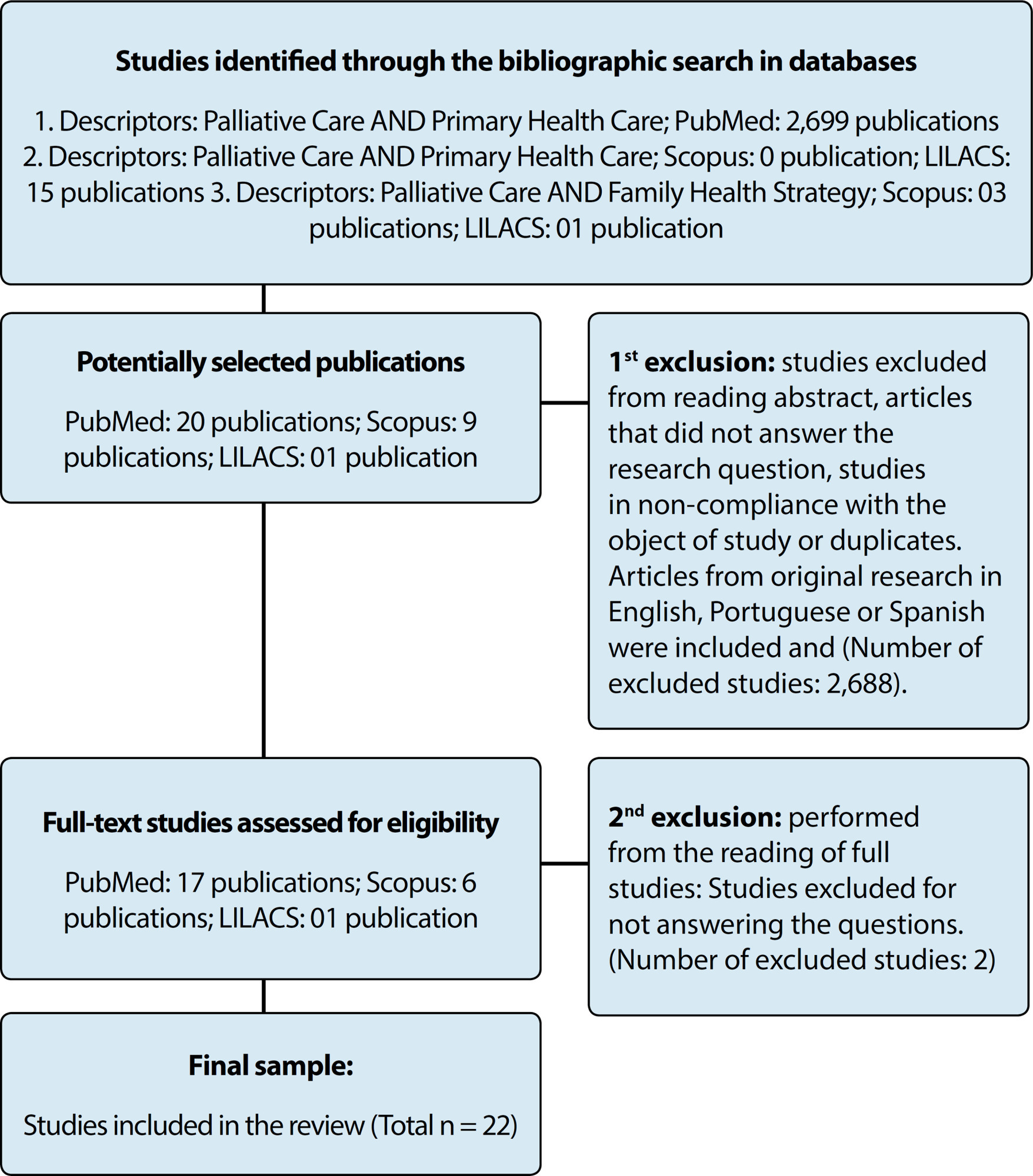
-
REVIEW09-29-2022
Children with congenital heart disease in COVID-19 pandemic times: an integrative review
Revista Brasileira de Enfermagem. 2022;75(1):e20201033
Abstract
REVIEWChildren with congenital heart disease in COVID-19 pandemic times: an integrative review
Revista Brasileira de Enfermagem. 2022;75(1):e20201033
DOI 10.1590/0034-7167-2020-1033
Views0See moreABSTRACT
Objective:
to identify the scientific production in health about children with congenital heart disease in COVID-19 pandemic times.
Method:
this is an integrative review, carried out in June 2020 in the information resources Latin American and Caribbean Literature in Health Sciences (LILACS), National Library of Medicine, National Institutes of Health (PubMed), Scientific Electronic Library Online Journal Portal (SciELO) and Brazilian Institute of Information Science and Technology (Oasis Ibict).
Results:
14 studies composed this review. Most studies pointed to tests, interventional procedures and surgery for children with heart disease in pandemic times; others discussed possible complications of COVID-19 among children with congenital heart disease.
Conclusion:
the incipient production of studies and the weak level of evidence denote an important knowledge gap so far, highlighting the need for studies with strong scientific evidence for the formulation of care guidelines aimed at children with heart disease.
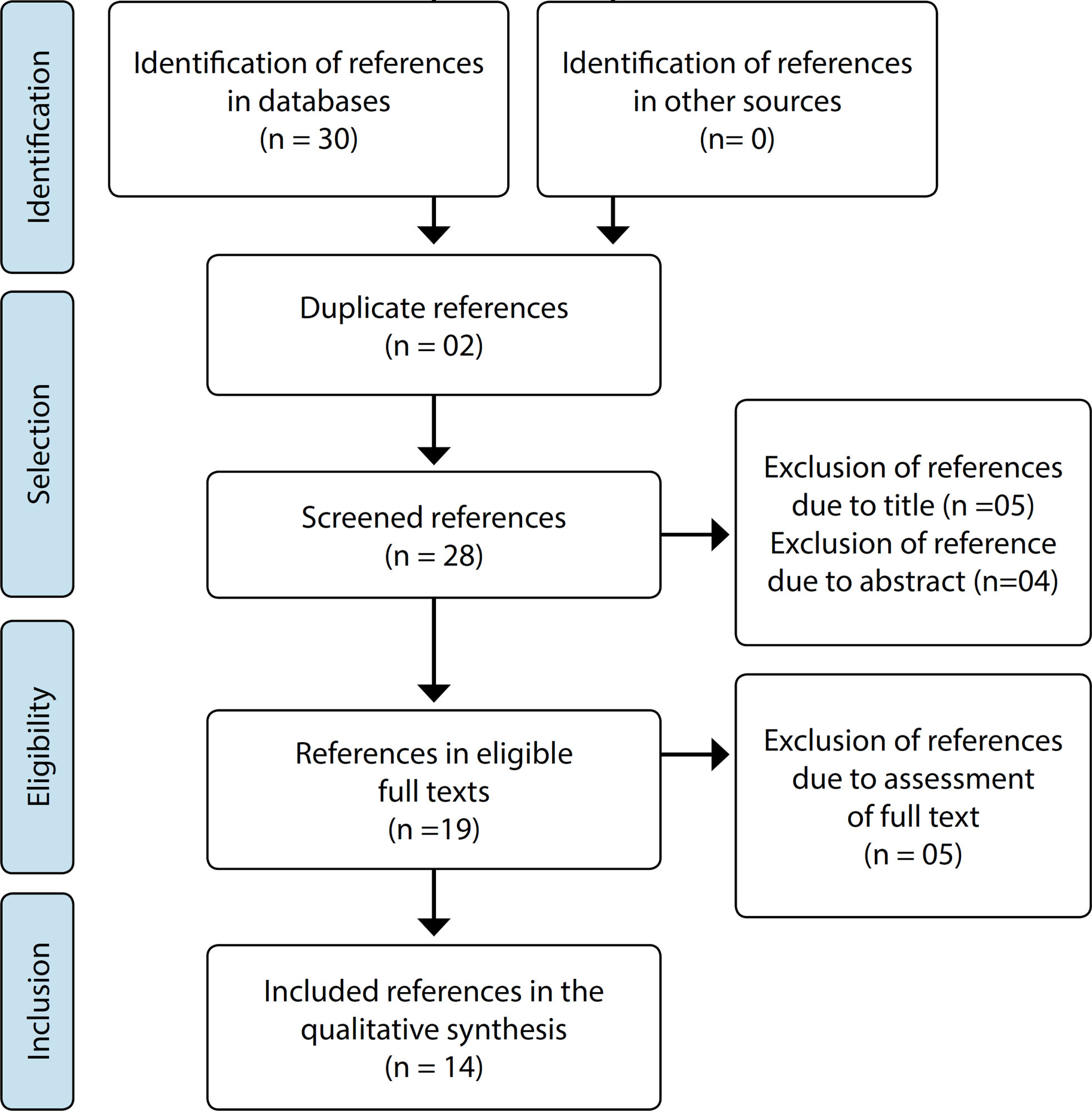
-
ORIGINAL ARTICLE09-29-2022
Palliative care production for health professionals in the context of home care
Revista Brasileira de Enfermagem. 2022;75(1):e20210030
Abstract
ORIGINAL ARTICLEPalliative care production for health professionals in the context of home care
Revista Brasileira de Enfermagem. 2022;75(1):e20210030
DOI 10.1590/0034-7167-2021-0030
Views1See moreABSTRACT
Objectives:
to analyze palliative care production developed by health professionals to home care patients.
Methods:
this is an exploratory study, with a qualitative approach, using the transpersonal care theoretical framework. Thirteen interviews were conducted with health professionals and 18 observations were conducted on different cases. Content analysis was performed using MAXQDA©.
Results:
actions performed: maintenance and follow-up measures to people eligible for palliative care, in acts of dialogue and “listening” to caregivers and users, conducting guidelines for the care and self-care process, performing technical procedures, delivery of materials, referrals and medical prescriptions to users.
Final Considerations:
it is perceived the need for advances in the implementation of government policies in Brazil that insert palliative care into the Health Care Network through educational, managerial and care actions that ensure human dignity, thus allowing the development of these and other palliative care interventions.
-
ORIGINAL ARTICLE09-29-2022
Incidence of acute radiodermatitis in women with breast cancer undergoing hypofractionated radiotherapy
Revista Brasileira de Enfermagem. 2022;75(1):e20210118
Abstract
ORIGINAL ARTICLEIncidence of acute radiodermatitis in women with breast cancer undergoing hypofractionated radiotherapy
Revista Brasileira de Enfermagem. 2022;75(1):e20210118
DOI 10.1590/0034-7167-2021-0118
Views0See moreABSTRACT
Objective:
To estimate the incidence and degree of acute radiodermatitis at the end and after the end of treatment in women with breast cancer undergoing hypofractionated radiotherapy.
Methods:
Observational, prospective, and longitudinal study, conducted between March 2019 and January 2020, in a radiotherapy outpatient clinic.
Results:
Thirty-two women participated in the study, among whom, in the last session of hypofractionated radiotherapy, 15 (46.9%) had radiodermatitis, erythema in 13 (40.6%), and wet peeling in 2 (6.3%). In the post-treatment evaluation, 27 (84.4%) had radiodermatitis, erythema in 17 (53.1%), dry peeling in 8 (25%), and wet peeling in 2 (6.3%).
Conclusion:
The general incidence of radiodermatitis after hypofractionated radiotherapy in women with breast cancer was 37.5%, erythema, 12.5%, and dry peeling, 25%. The development of care protocols for the management of radiodermatitis after treatment is of paramount importance.
-
ORIGINAL ARTICLE09-29-2022
Neither angels nor heroes: nurse speeches during the COVID-19 pandemic from a Foucauldian perspective
Revista Brasileira de Enfermagem. 2022;75:e20201329
Abstract
ORIGINAL ARTICLENeither angels nor heroes: nurse speeches during the COVID-19 pandemic from a Foucauldian perspective
Revista Brasileira de Enfermagem. 2022;75:e20201329
DOI 10.1590/0034-7167-2020-1329
Views1See moreABSTRACT
Objective:
to analyze the processes of meaning production, based on the speeches of nursing professionals, about how they feel about the titles of “angels and heroes” given by society during the pandemic of COVID-19.
Methods:
a qualitative, documentary research. Data was collected in October and November 2020 and analyzed from the perspective of the Discourse Analysis proposed by Michel Foucault.
Results:
they were organized into two thematic categories: “Angels and heroes? The (not) heroic reality of nursing during the pandemic” and “The search for recognition of the professional work of nursing: between what is said and what is not said”.
Final considerations:
the nurses’ speeches enunciate the search for decent conditions for the execution of care, fair wages, and recognition of the professional work by society.
-
EXPERIENCE REPORT09-29-2022
Mobile pre-hospital care reorganization during the COVID-19 pandemic: experience report
Revista Brasileira de Enfermagem. 2022;75:e20200826
Abstract
EXPERIENCE REPORTMobile pre-hospital care reorganization during the COVID-19 pandemic: experience report
Revista Brasileira de Enfermagem. 2022;75:e20200826
DOI 10.1590/0034-7167-2020-0826
Views0See moreABSTRACT
Objective:
To describe the reorganization of Belo Horizonte’s Mobile Emergency Care Service during the new coronavirus pandemic using the Plan Do-Check-Act quality tool.
Methods:
Descriptive study, of the experience report type, on the reorganization of care in a mobile pre-hospital care service during the new coronavirus pandemic, from March to July 2020. The Plan-Do-Check-Act quality tool was applied for the process.
Results:
Preparation of care protocol, meetings, training, addition of ambulances, hiring of professionals, and other actions were carried out, with subsequent evaluation and monitoring. When failures or new needs were identified, actions and changes were implemented while keeping monitoring and evaluation during the work routine.
Final considerations:
The reorganization of the service through the construction of a protocol and using the Plan-Do-Check-Act as a management tool was essential to promote safe care for professionals and patients.

-
REFLECTION09-29-2022
Health care of deaf persons during coronavirus pandemics
Revista Brasileira de Enfermagem. 2022;75:e20201036
Abstract
REFLECTIONHealth care of deaf persons during coronavirus pandemics
Revista Brasileira de Enfermagem. 2022;75:e20201036
DOI 10.1590/0034-7167-2020-1036
Views0See moreABSTRACT
Objective:
To reflect about the barriers experienced by the deaf population during the COVID-19 pandemic, the proposals to overcome communication barriers in health care and the role of public policies in effecting the social inclusion of deaf people.
Methods:
Reflection based on studies on health care for deaf people, the COVID-19 pandemic and public accessibility policies.
Results:
The global crisis of COVID-19 has deepened pre-existing inequalities in the world, in addition to highlighting the vulnerability of people with disabilities, including deaf. Government, institutional and social initiatives to mitigate difficulties in communicating to deaf people have been made, but they are still insufficient to guarantee protection for them in this pandemic and full inclusion in health care.
Final considerations:
Social inclusion, supported by law, and the linguistic accessibility of deaf people still need to generate broad and concrete actions so that deaf people can enjoy their rights as citizens.
-
REFLECTION09-29-2022
Hemodialysis in the context of COVID-19: care, nursing protagonism and quality
Revista Brasileira de Enfermagem. 2022;75:e20201077
Abstract
REFLECTIONHemodialysis in the context of COVID-19: care, nursing protagonism and quality
Revista Brasileira de Enfermagem. 2022;75:e20201077
DOI 10.1590/0034-7167-2020-1077
Views0See moreABSTRACT
Objective:
To reflect on the need to reorganize satellite dialysis units to ensure the safety of patients and workers, focusing on minimizing the risk of contamination by SARS-CoV-2.
Methods:
Reflection considering the guidelines of international and Brazilian institutions and scientific articles, with a view to possible adaptations to the Brazilian reality.
Results:
The actions suggested and adapted by Dialysis Units from different countries during the pandemic focus on the quality of care and safety of the patient and workers. There was an opportunity to reflect on these actions using the Donabedian Model for quality of care and highlight the nursing team’s role in this context.
Final considerations:
The focus on quality and safety related to institutionalized processes and the assessment through indicators can contribute to the management of the outpatient dialysis unit in the context of COVID 19.
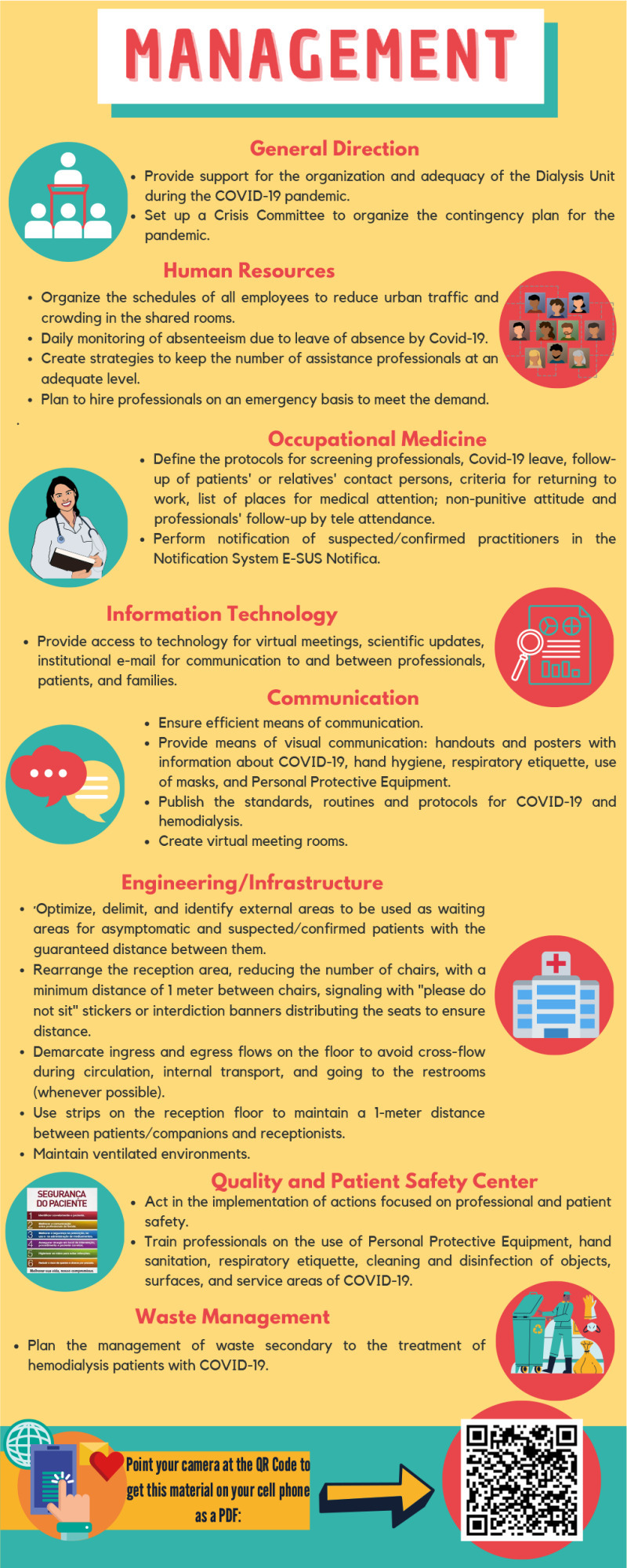
-
REVIEW06-10-2022
Self-inflicted violence and suicide in people living with HIV/AIDS: a systematic review
Revista Brasileira de Enfermagem. 2022;75:e20210768
Abstract
REVIEWSelf-inflicted violence and suicide in people living with HIV/AIDS: a systematic review
Revista Brasileira de Enfermagem. 2022;75:e20210768
DOI 10.1590/0034-7167-2021-0768
Views0See moreABSTRACT
Objectives:
to analyze intellectual productions on self-inflicted violence and suicide in people living with HIV/AIDS.
Methods:
a systematic review, carried out between March and April 2021, in the PubMed®/MEDLINE®, Web of Science and LILACS databases, subsidized in the Strengthening the Reporting of Observational Studies in Epidemiology. The period outlined was from 2011 to 2020.
Results:
a total of 199 studies were identified, and 16 composed the final sample, grouped into the categories: Sociodemographic characteristics of victims of self-inflicted violence/suicide and their intervening factors (pointing to young adults, especially homosexuals, with low social support and a history of mental illness or substance abuse as usual victims); Successful measures for suicide prevention/control in people living with HIV/AIDS (suggesting more frequent psychosocial and clinical follow-up of those starting antiretroviral and immunocompromised treatment).
Conclusions:
biopsychosocial follow-up, analysis of sociodemographic profile and intervening factors should be frequent in this population for disease prevention/control.

-
ORIGINAL ARTICLE09-05-2022
Screening for common mental disorder in elderly residents in the countryside: a cross-sectional study
Revista Brasileira de Enfermagem. 2022;75:e20210875
Abstract
ORIGINAL ARTICLEScreening for common mental disorder in elderly residents in the countryside: a cross-sectional study
Revista Brasileira de Enfermagem. 2022;75:e20210875
DOI 10.1590/0034-7167-2021-0875
Views0See moreABSTRACT
Objective:
To estimate the prevalence of common mental disorders and their associated factors in the elderly in a municipality in the countryside of the Brazilian Midwest.
Methods:
Quantitative, observational, cross-sectional approach research, conducted with 218 elderly people.
Results:
The prevalence of the common mental disorder among the elderly was 25.1%; in the univariate analysis, it was higher in females (35.4%), in the age group of 80 years or older (46.1%), brown skin color (30.2%), widowed (42.6%), illiterate (47.6%), and retired (27.6%). In the multiple analysis, the variables female gender (p<0.006), age 80 years or older (p<0.036), dissatisfaction with life (p<0.009), lack of social interaction (p=0.017), and dysfunctional family (p=0.021) remained associated with CMD.
Conclusion:
The results revealed are helpful and contribute to the reinforcement of the need for mental health care in this population extract so growing worldwide.
-
ORIGINAL ARTICLE06-03-2022
Association between falls in older adults and prevention group
Revista Brasileira de Enfermagem. 2022;75:e20200207
Abstract
ORIGINAL ARTICLEAssociation between falls in older adults and prevention group
Revista Brasileira de Enfermagem. 2022;75:e20200207
DOI 10.1590/0034-7167-2020-0207
Views0See moreABSTRACT
Objectives:
to assess the effectiveness of guidelines on fall prevention in a group of older adults in Primary Health Care.
Methods:
a cross-sectional study, carried out with older adults selected by a simple random sample (274; N=1,234). Data covered sociodemographic and socioeconomic variables, marital status, health conditions, factors associated with falls and participation in the prevention group. Student’s t test was used, and dichotomous variables were used by the chi-square test. The project met ethical requirements.
Results:
sample with female profile (61.7%), married, with low education, mean age of 71.69 years. The factors associated with falls identified were female sex, medicalization and participation in the prevention group. There was no protective association between participation in a fall prevention group in older adults and a decrease in the number of falls.
Conclusions:
based on evidence, a personalized intervention during the nursing visit is suggested as a strategy to prevent falls.

-
ORIGINAL ARTICLE03-07-2022
Predictors of frailty in older people users of Primary Health Care
Revista Brasileira de Enfermagem. 2022;75:e20201292
Abstract
ORIGINAL ARTICLEPredictors of frailty in older people users of Primary Health Care
Revista Brasileira de Enfermagem. 2022;75:e20201292
DOI 10.1590/0034-7167-2020-1292
Views0See moreABSTRACT
Objective:
to identify the prevalence and predictors of frailty in older people in Primary Health Care.
Method:
this is a descriptive and correlational study, carried out in a convenience sample of 136 older people in the community. Data were collected through a sociodemographic and clinical questionnaire and frailty phenotype. Student’s t test or U-Mann-Whitney test, chi-square and binary logistic regression were used for data analysis.
Results:
the prevalence of frailty was 26.5% (n=36). Frail individuals had older age (p=0.011), worse self-rated health (p=0.001) and lower physical capacity (p<0.001). In the multivariable regression, it was observed that frail individuals had older age (Odds Ratio=1.111; 95% confidence interval=1.026-1.203) and worse physical capacity (Odds Ratio=0.673; 95% confidence interval=0.508-0.893).
Conclusions:
the prevalence of frailty in older people in Primary Health Care was considerable. Advanced age and worse physical capacity were the most relevant predictors of frailty in the elderly.
-
ORIGINAL ARTICLE04-15-2022
Validation of Questionnaire to Assess the Impact of Dementia on the Family
Revista Brasileira de Enfermagem. 2022;75:e20210232
Abstract
ORIGINAL ARTICLEValidation of Questionnaire to Assess the Impact of Dementia on the Family
Revista Brasileira de Enfermagem. 2022;75:e20210232
DOI 10.1590/0034-7167-2021-0232
Views0See moreABSTRACT
Objective:
To validate a questionnaire to assess the impact of dementia on one of the household members.
Methods:
Methodological study. The instrument was designed based on literature review, expert opinion, and researchers’ experience and then applied to a non-probability convenience sample consisting of 262 family members who live daily with a person with dementia. The construct validity was studied by exploratory factor analysis, principal components method, with varimax rotation of the items.
Results:
An instrument with 30 items was obtained, distributed in four dimensions: “Emotional dimension,” “Economic dimension,” “Family relations dimension,” and “Support-seeking dimension.” Factor analysis revealed a total explained variance of 54.96% and a total Cronbach’s alpha of .899.
Conclusions:
The instrument presents high internal consistency, grouped into four dimensions, all closely related to the family’s adaptation to the onset of dementia in one of its members.
-
ORIGINAL ARTICLE03-07-2022
Is self-esteem associated with the elderly person’s quality of life?
Revista Brasileira de Enfermagem. 2022;75:e20210388
Abstract
ORIGINAL ARTICLEIs self-esteem associated with the elderly person’s quality of life?
Revista Brasileira de Enfermagem. 2022;75:e20210388
DOI 10.1590/0034-7167-2021-0388
Views0See moreABSTRACT
Objective:
To analyze the association between self-esteem and quality of life in the elderly.
Methods:
Cross-sectional web survey developed with 519 elderly people. Participants filled out three data collection instruments developed on the Google Forms platform and widely disseminated through all of Brazil. Fisher’s exact test, Mann-Whitney, Pearson correlation, and linear regression with 95% confidence interval were used.
Results:
Self-esteem was associated with all quality-of-life facets: sensory skills [β= 1.307; p<0.001]; autonomy [β= 2.101; p<0.001]; past, present, and future activities [β= 2.486; p<0.001]; social presence [β= 2.547; p<0.001]; death and dying [β= 2.175; p<0.001]; and intimacy [β=2.378; p<0.001].
Conclusion:
There is a positive and statistically significant association between self-esteem and quality of life in the elderly. We therefore suggest the development of local policies capable of raising this age groups’ self-esteem and reaffirming aging as a new possibility for discoveries and pleasure.
-
EXPERIENCE REPORT10-24-2022
Nursing process for elderly women susceptible to falls from the perspective of the Pender’s Model
Revista Brasileira de Enfermagem. 2022;75:e20210913
Abstract
EXPERIENCE REPORTNursing process for elderly women susceptible to falls from the perspective of the Pender’s Model
Revista Brasileira de Enfermagem. 2022;75:e20210913
DOI 10.1590/0034-7167-2021-0913
Views0See moreABSTRACT
Objectives:
to describe the strategy of applying the nursing process guided by Pender’s Health Promotion Model to elderly women susceptible to falls with a view to promoting a self-efficacy behavior for fall prevention.
Methods:
application of the nursing process to eleven elderly women who had already experienced falls, living in a neighborhood in the outskirts of Belem, state of Pará, which involved interviews to obtain their nursing history and group meetings using the focus group technique to develop the other phases of the nursing process: nursing diagnosis, nursing interventions, and nursing assessment.
Results:
despite the risk factors for falls, the intervention model adopted in this study allowed elderly women to enhance their self-efficacy.
Final Considerations:
the model proved to be suitable for the participation of elderly women in actions to build fall prevention behaviors, with a view to healthier lifestyles.

-
ORIGINAL ARTICLE10-24-2022
Factors associated with symptoms of physical and emotional burden in informal caregivers of the elderly
Revista Brasileira de Enfermagem. 2022;75:e20210927
Abstract
ORIGINAL ARTICLEFactors associated with symptoms of physical and emotional burden in informal caregivers of the elderly
Revista Brasileira de Enfermagem. 2022;75:e20210927
DOI 10.1590/0034-7167-2021-0927
Views1See moreABSTRACT
Objectives:
to analyze the personal and work-related burden factors associated with physical and emotional symptoms of informal caregivers of the elderly.
Methods:
cross-sectional study conducted with 121 informal caregivers and 121 seniors who received care, assessed individually for the risk of: physical overload, musculoskeletal symptoms, Self-Reporting Questionnaire, effort perception, and Katz index.
Results:
a greater perception of effort raises up to 3.3 times the chances of presenting symptoms of pain in the spine region (p=0.01), and lower functional capacity of the elderly increases up to 1.3 times the chances of presenting pain symptoms in the spine region (p=0.02). The symptoms of emotional overload were associated with the caregiver’s low income (p=0.02).
Conclusions:
the perception of effort, dependence of the elderly, caregiver’s age, and symptoms of emotional overload are involved with caregivers’ symptoms of physical overload, and low income, with emotional overload.
-
REVIEW06-17-2020
The role of the nurse in caring for the critical patient with sepsis
Revista Brasileira de Enfermagem. 2020;73(4):e20190031
Abstract
REVIEWThe role of the nurse in caring for the critical patient with sepsis
Revista Brasileira de Enfermagem. 2020;73(4):e20190031
DOI 10.1590/0034-7167-2019-0031
Views0See moreABSTRACT
Objectives:
to know the nursing interventions in the identification, prevention and control of sepsis in critical patients.
Methods:
integrative review of the literature, with two parallel researches using different MesH terms, using the EBSCO database and Google Scholar. Nine studies were included in the sample.
Results:
nursing interventions are centered on the creation/implementation of protocols for the early recognition of sepsis, the training of teams to ensure a safe and effective approach and the adoption of measures for infection prevention and control as a way to prevent sepsis.
Final Considerations:
the evidence shows that nurses are fundamental in the early identification, control and prevention of sepsis, preventing disease progression and contributing to decreased morbidity and mortality.
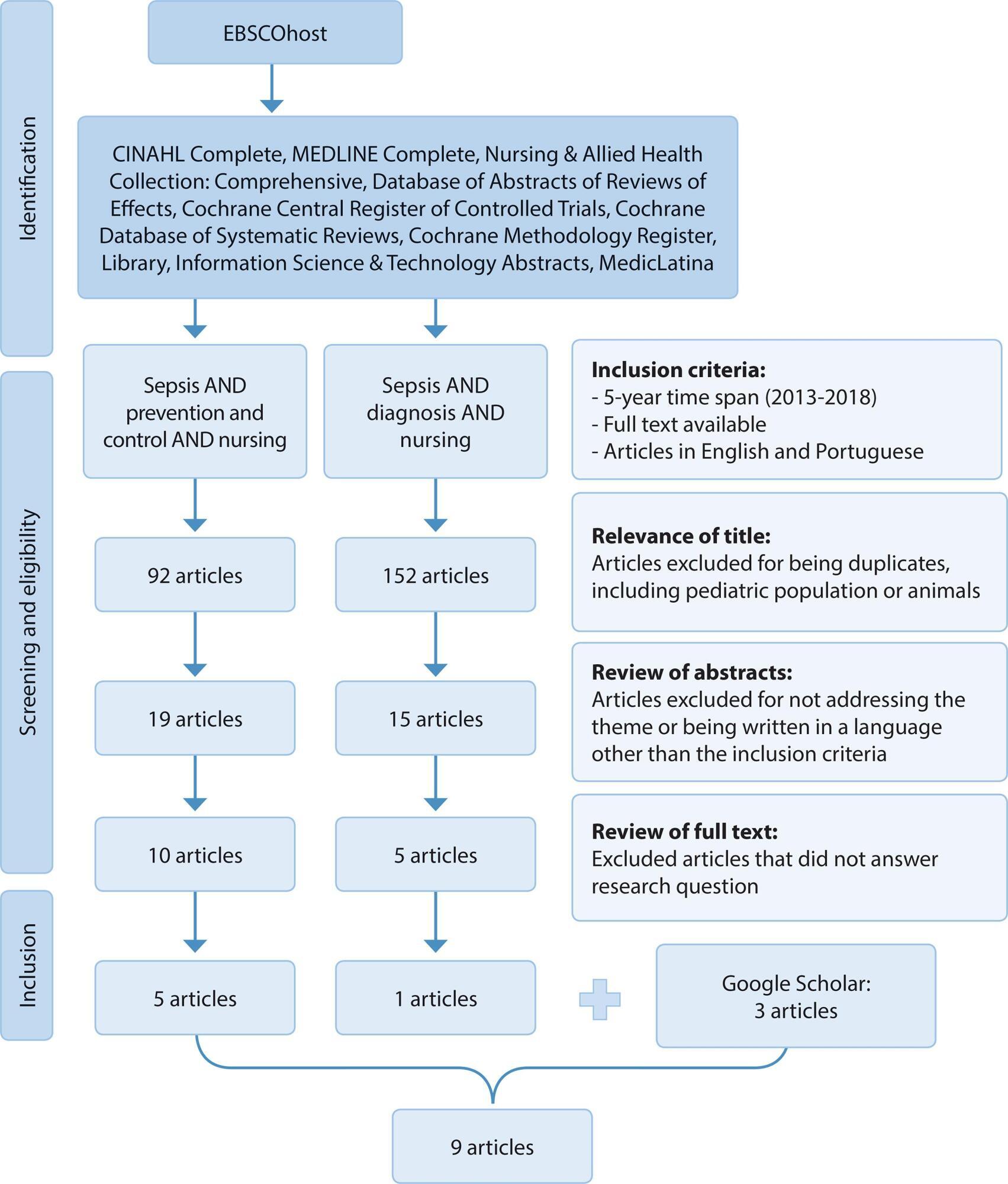
-
ORIGINAL ARTICLE02-10-2020
Common Mental Disorders and Contemporary Factors: 1982 Birth Cohort
Revista Brasileira de Enfermagem. 2020;73(1):e20180162
Abstract
ORIGINAL ARTICLECommon Mental Disorders and Contemporary Factors: 1982 Birth Cohort
Revista Brasileira de Enfermagem. 2020;73(1):e20180162
DOI 10.1590/0034-7167-2018-0162
Views0See moreABSTRACT
Objective:
To describe the association between common mental disorders and socio-demographic variables, smoking habits and stressful events among the 30-year-old members of a 1982 cohort.
Method:
Mental disorder was analyzed by the Self-Reporting Questionnaire (SRQ-20). Poisson regression was used to analyze the unadjusted and adjusted associations.
Results:
Low level of education and stressful events increased the prevalence of mental disorders for both genders. Lower income for women and unemployment for men also remained associated with CMD.
Conclusion:
It was possible to describe the association between contemporary factors and mental disorders in a young population, to which prevention and control measures, through public policies proposed to the areas of Primary Care, Mental Health and Education, can represent a better quality of life and health.
-
ORIGINAL ARTICLE09-21-2020
Prevalence of xerostomia in women during breast cancer chemotherapy
Revista Brasileira de Enfermagem. 2020;73:e20190785
Abstract
ORIGINAL ARTICLEPrevalence of xerostomia in women during breast cancer chemotherapy
Revista Brasileira de Enfermagem. 2020;73:e20190785
DOI 10.1590/0034-7167-2019-0785
Views0See moreABSTRACT
Objective:
To identify the prevalence of xerostomia in women undergoing chemotherapy for breast cancer.
Method:
Prospective cohort with 27 women who underwent up to 16 sessions of intravenous chemotherapy. Data collection was performed at the outpatient clinic of a university hospital in the city of São Paulo, where two forms were applied before the start of treatment and the Xerostomia Inventory before and after each chemotherapy session.
Results:
Complaints of dry mouth were present in 48.1% of women before chemotherapy, and they were approximately 28 times more likely to develop dry mouth during treatment. It was observed that the use of antiemetics contributed to the occurrence of xerostomia, and the anti-ulcerous were presented as a protective factor.
Conclusion:
The study identified both a high prevalence of xerostomia regardless of the chemotherapy used and the need to create protocols to improve the quality of life of these patients.
-
ORIGINAL ARTICLE12-13-2019
Hammock and nesting in preterm infants: randomized controlled trial
Revista Brasileira de Enfermagem. 2019;72:96-102
Abstract
ORIGINAL ARTICLEHammock and nesting in preterm infants: randomized controlled trial
Revista Brasileira de Enfermagem. 2019;72:96-102
DOI 10.1590/0034-7167-2018-0099
Views0See moreABSTRACT
Objective:
To compare the physiological variables and the sleep-wake pattern presented by preterm in nesting and hammock positions after diaper change.
Method:
This is a crossover randomized controlled trial. It was conducted with 20 preterm infants who, after diaper change, were placed in nests or hammocks. These preterm infants were evaluated for physiological variables (heart rate and oxygen saturation) and behavioral variables (sleep and wakefulness).
Results:
There was no statistically significant difference in the studied variables between nesting and hammock positions. However, regarding the categorical variable sleep, the comparison between the research phases for the hammock position showed differences between the baseline phase and the immediate recovery (p=0.00), baseline and late recovery (p=0.00), response and immediate recovery (p=0.00), response and late recovery (p=0.00).
Conclusion:
No differences were identified between the nest and the hammock; however, the use of the hammock favored the sleep of preterm infants compared to its non-use.
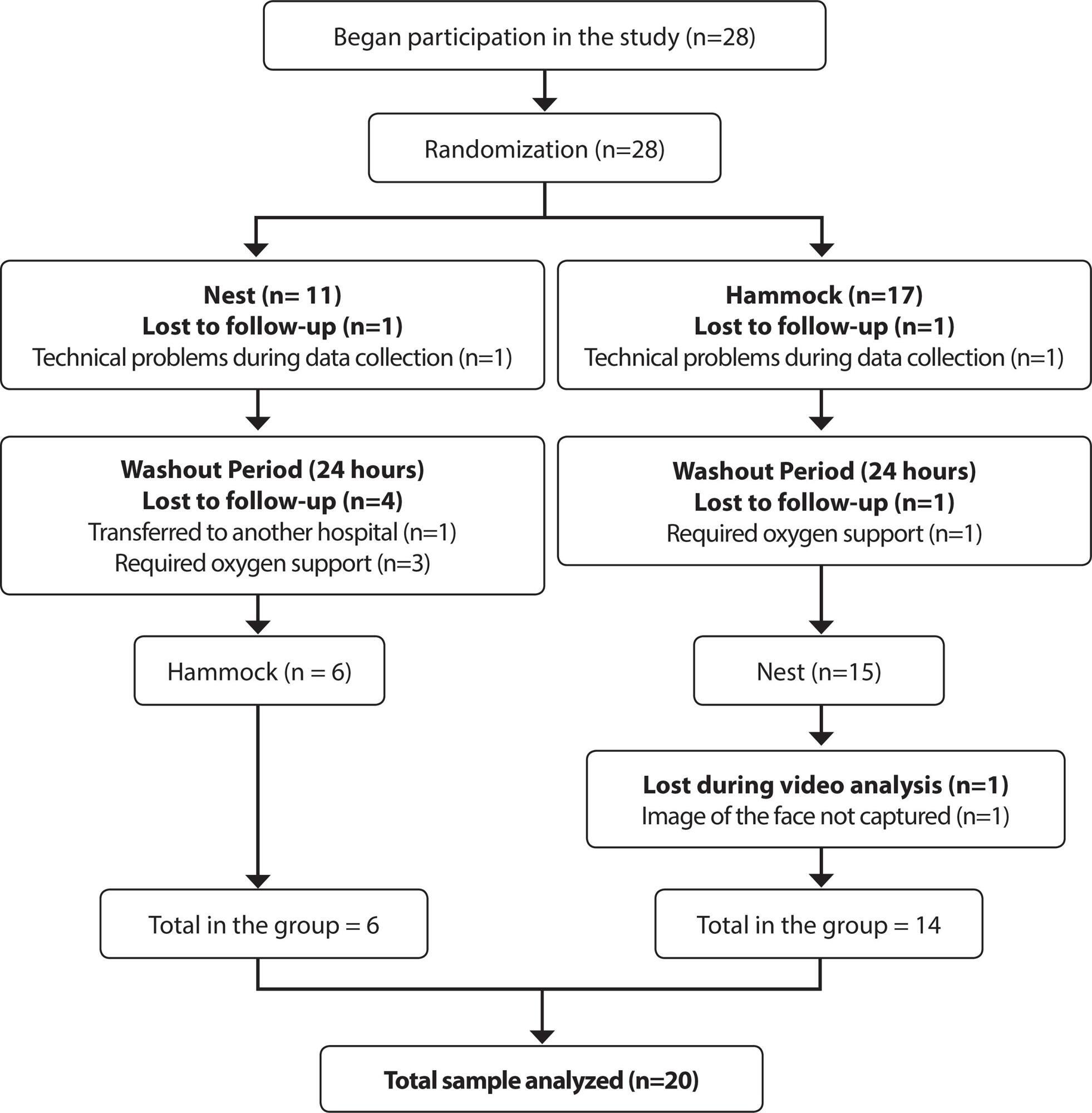
-
ORIGINAL ARTICLE05-15-2020
Configuration of power relations in physicians and nurses’ professional practices
Revista Brasileira de Enfermagem. 2020;73:e20180629
Abstract
ORIGINAL ARTICLEConfiguration of power relations in physicians and nurses’ professional practices
Revista Brasileira de Enfermagem. 2020;73:e20180629
DOI 10.1590/0034-7167-2018-0629
Views0See moreABSTRACT
Objective:
to analyze the configuration of power relations constituted in and by the knowledge and daily practices of physicians and nurses in an Intensive Care Unit (ICU).
Method:
qualitative study in which data were collected through interviews with physicians and nurses from an ICU of a hospital in Belo Horizonte, Minas Gerais. A semi-structured script was used. Data were analyzed through discourse analysis in a Foucaultian perspective.
Results:
three categories were developed – Professional Identity: self-recognition in the profession; Discipline: individualizing attitudes or collective need?; and Circularity of knowledge and power in the constitution of daily practices.
Final considerations:
the identity, discipline and circulation of power are connected in a continuous movement of subjectivation of the subject, which, in turn, uses discourse as a persuasion strategy to modify the position taken over in different situations thereby causing the circulation of power.
-
REVIEW03-30-2020
Internet influence on the biopsychosocial health of adolescents: an integratitive review
Revista Brasileira de Enfermagem. 2020;73(2):e20180766
Abstract
REVIEWInternet influence on the biopsychosocial health of adolescents: an integratitive review
Revista Brasileira de Enfermagem. 2020;73(2):e20180766
DOI 10.1590/0034-7167-2018-0766
Views0See moreABSTRACT
Objectives:
To identify scientific evidence on the influence of internet use on adolescents’ biopsychosocial health.
Methods:
Integrative review, with database search, using the descriptors “internet”, “adolescent health” and “adolescent behavior”. After applying the inclusion and exclusion criteria, 16 articles were selected.
Results:
Knowledge convergence produced for three main themes was demonstrated: “Internet exposure time and possible damages to adolescent health”; “Internet, adolescent and cyberbullying”; and “Internet as a source of information for adolescent health”.
Final considerations:
The network involves an intricate network of interactions, providing varied behaviors and attitudes that reflect on adolescent health. Therefore, it is important to articulate nursing actions with the school community and the family, in order to carry out health education.
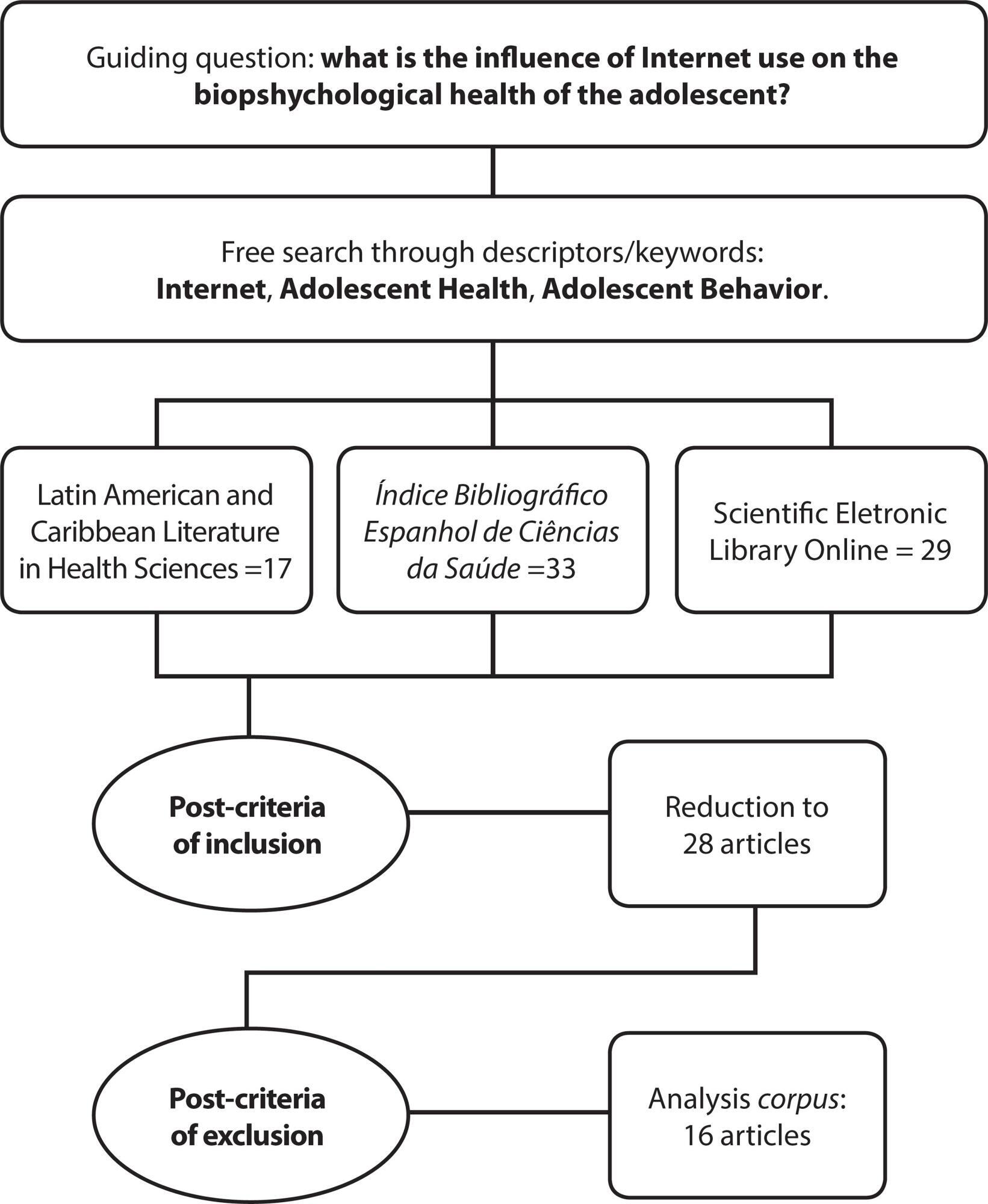
-
ORIGINAL ARTICLE02-17-2020
Analysis of records by nursing technicians and nurses in medical records
Revista Brasileira de Enfermagem. 2020;73(2):e20180542
Abstract
ORIGINAL ARTICLEAnalysis of records by nursing technicians and nurses in medical records
Revista Brasileira de Enfermagem. 2020;73(2):e20180542
DOI 10.1590/0034-7167-2018-0542
Views0See moreABSTRACT
Objectives:
to analyze the main non-conformities of the nursing records of a public hospital in Natal, Brazil.
Methods:
this is a descriptive, cross-sectional study, with a quantitative approach. This study was conducted in nursing departments of medical and surgical wards. The sample was composed of 120 medical records of inpatients between October and December 2016. The obtained data were tabulated and analyzed by simple statistics in absolute and relative frequency using the 2013 Microsoft Excel software. The Pareto Diagram was used to evaluate the non-conformities of the records.
Results:
the main problems in the nursing records were the absence of the professional category and the nursing council number, responsible for 41.8% of the non-conformities in the records of nursing technicians; for nurses’ records, the main non-conformities were the absence of time and the illegible handwriting, with 61.2%.
Conclusions:
the study showed that nursing professionals perform their records incompletely and often do not document the care provided.
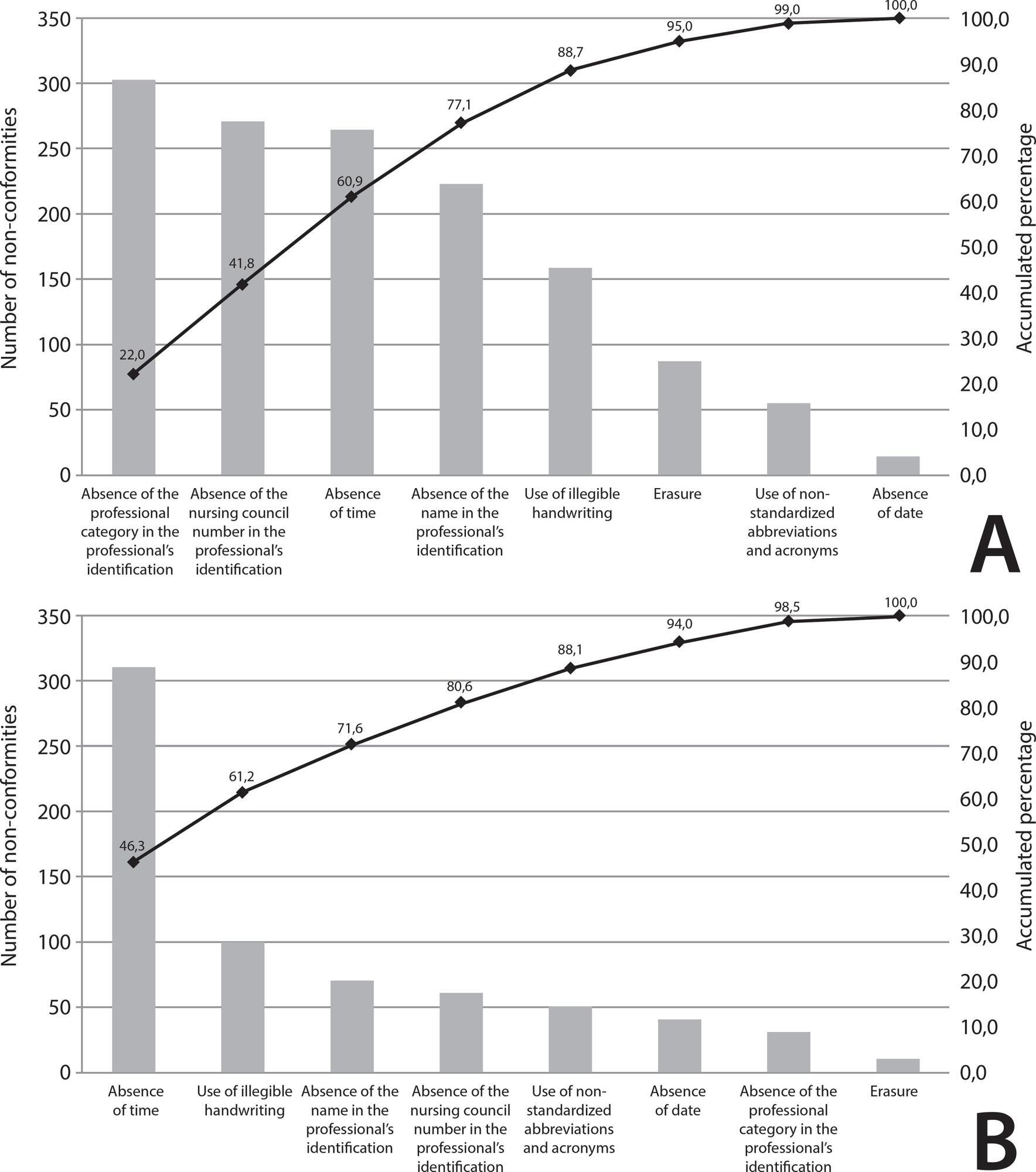
-
12-05-2019
Hospital care and urinary incontinence in the elderly
Revista Brasileira de Enfermagem. 2019;72:284-293
Abstract
Hospital care and urinary incontinence in the elderly
Revista Brasileira de Enfermagem. 2019;72:284-293
DOI 10.1590/0034-7167-2018-0273
Views0See moreABSTRACT
Objective:
to identify factors inherent in hospital care that favor urinary incontinence in the elderly.
Method:
an integrative review with Scopus, CINAHL and Pubmed searches. Includes original articles, no language restriction, published between 2008 and 2018. Rated level of recommendation and level of evidence were assessed using the Oxford Center for Evidence-Based Medicine classification. Exploited content through thematic analysis in light of the Donabedian model.
Results:
13 articles constituted the sample. There were factors such as the unjustified and indiscriminate use of devices such as the geriatric diaper; hospital structure adversely affecting the needs of the elderly; and deficit in screening, risk identification and underreporting of the problem favor urinary incontinence in the hospitalized elderly.
Conclusion:
modifiable factors related to hospital structures and care processes favor both the onset and worsening of urinary incontinence in the elderly.
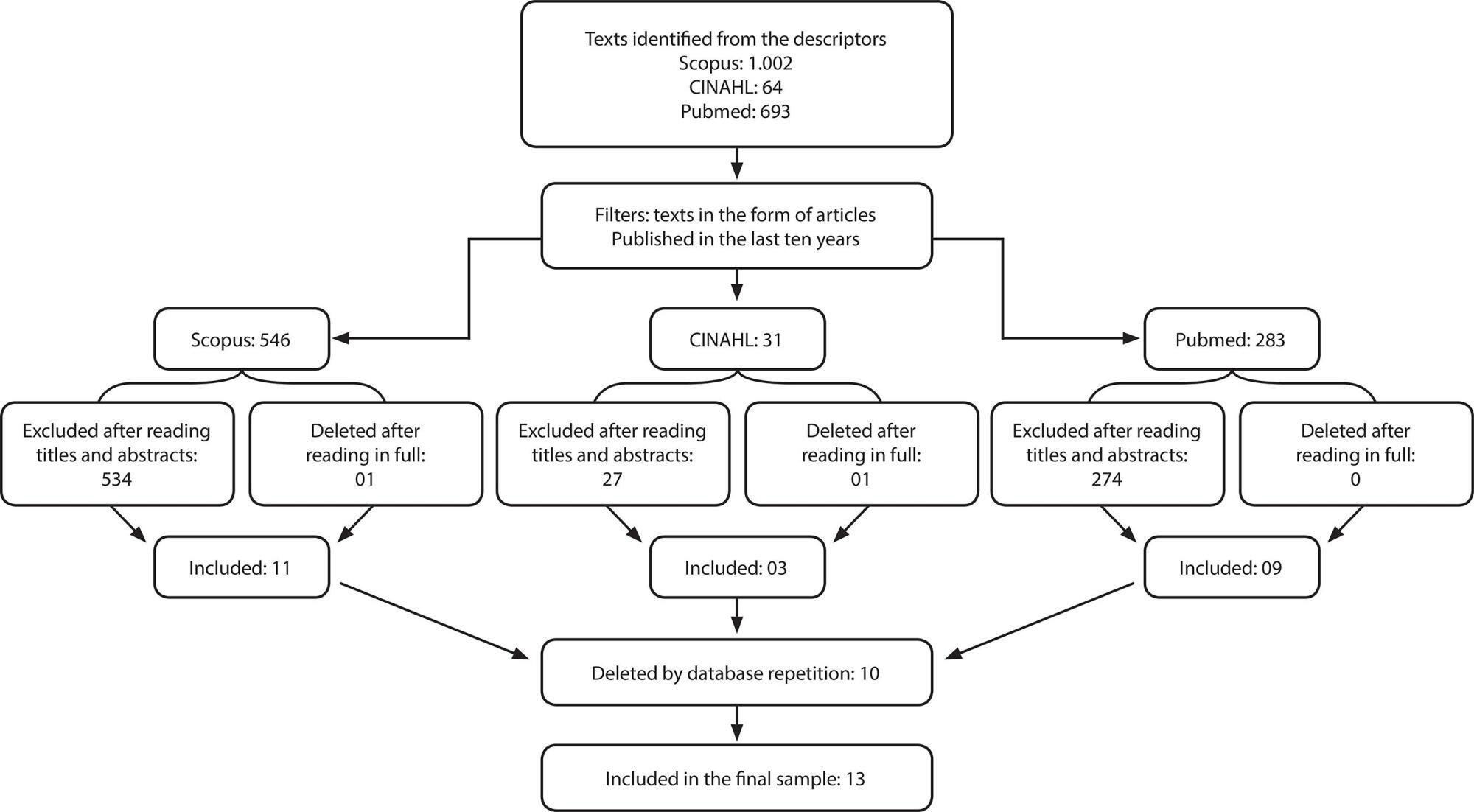
Search
Search in:
Nuvem de Tags
Adolescente (85) Atenção Primária à Saúde (239) COVID-19 (91) Criança (91) Cuidados de Enfermagem (269) Educação em Enfermagem (151) Educação em Saúde (139) Enfermagem (930) Enfermagem Pediátrica (86) Estudantes de Enfermagem (77) Estudos de Validação (131) Família (87) Idoso (208) Promoção da Saúde (99) Qualidade de Vida (104) Saúde do Trabalhador (86) Saúde Mental (145) Saúde Pública (82) Segurança do Paciente (150) Tecnologia Educacional (100)



